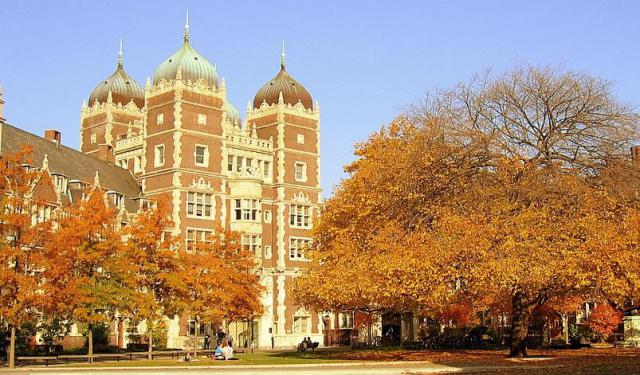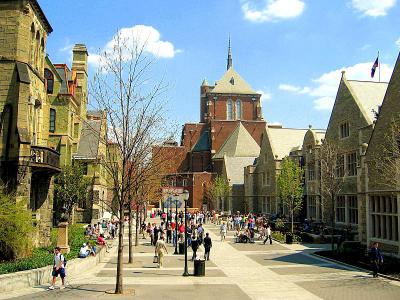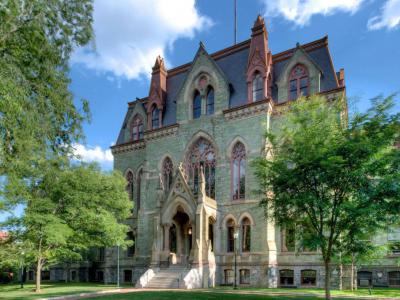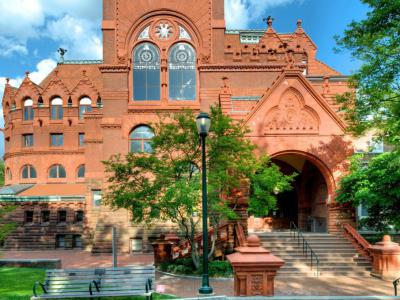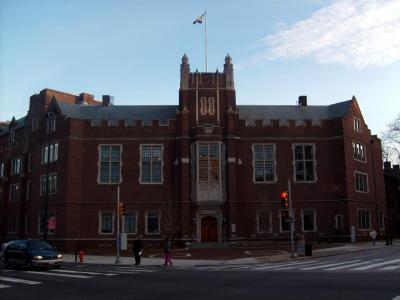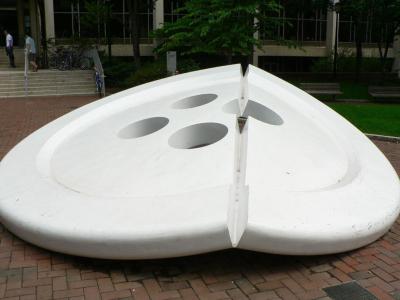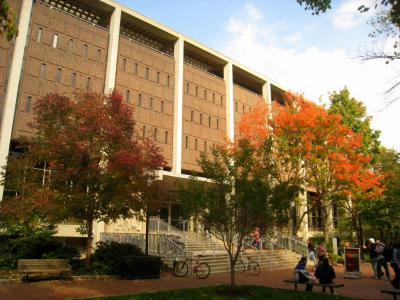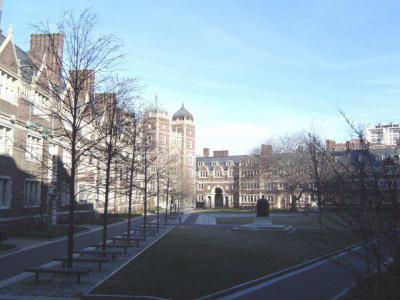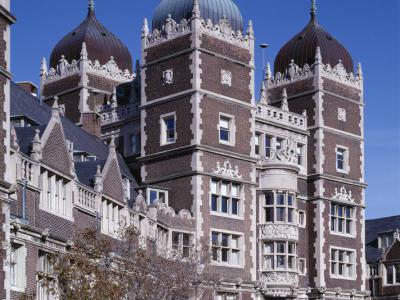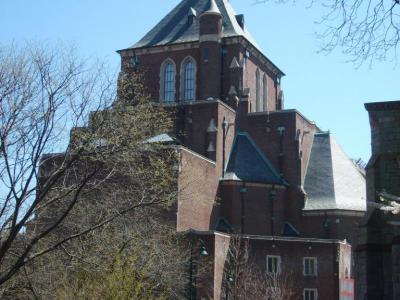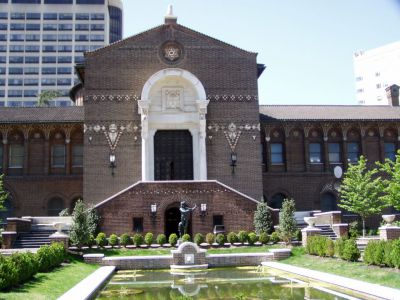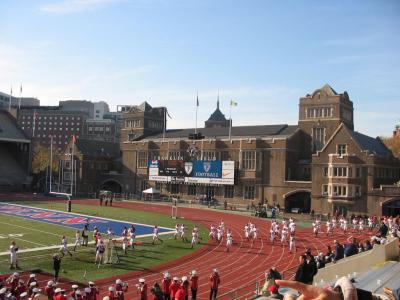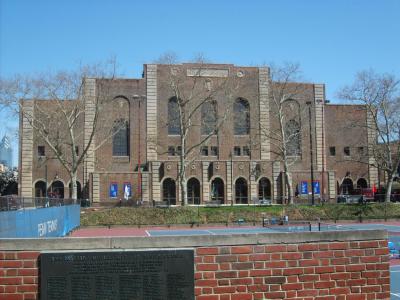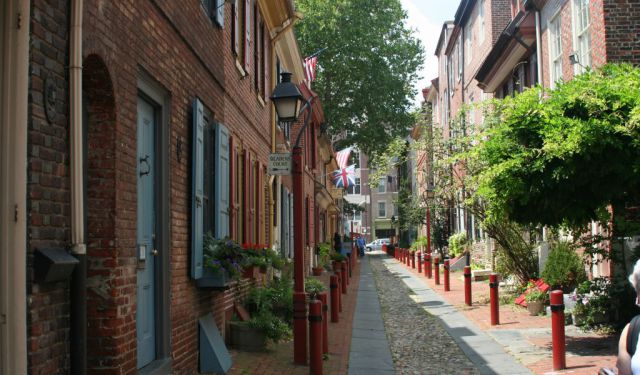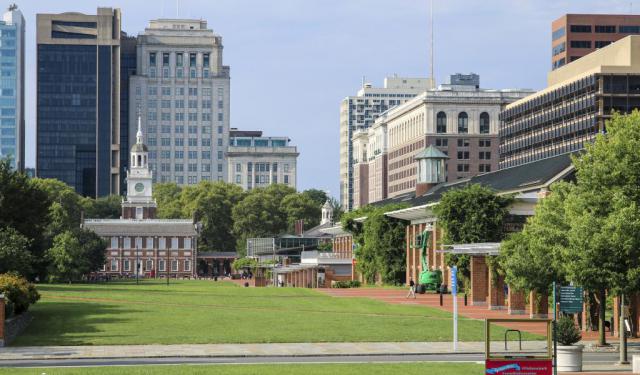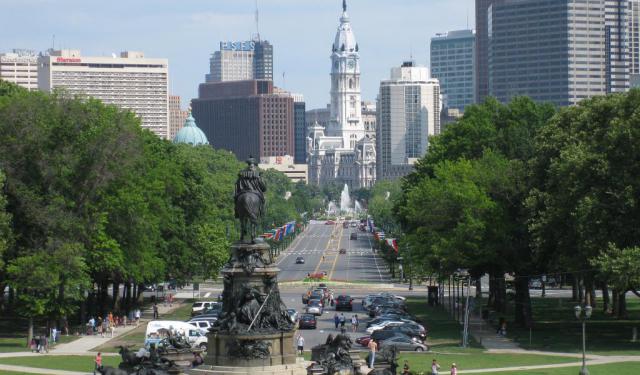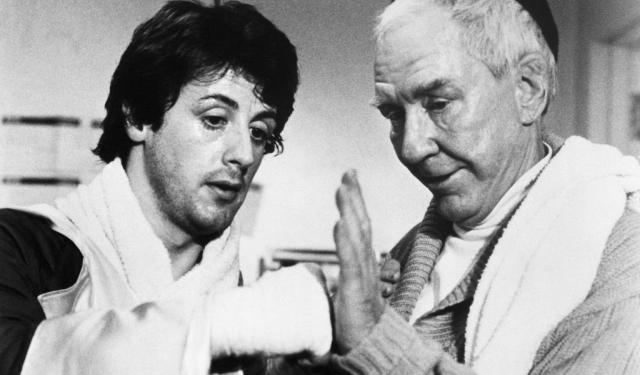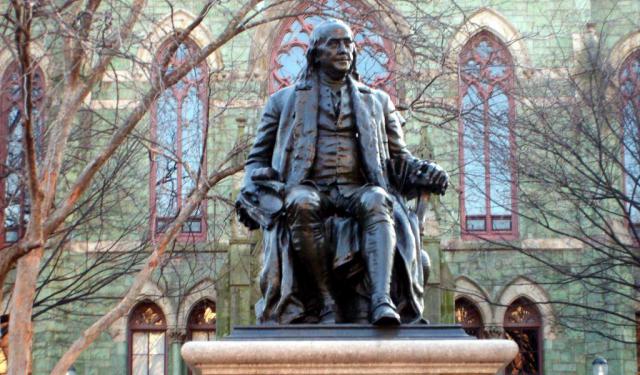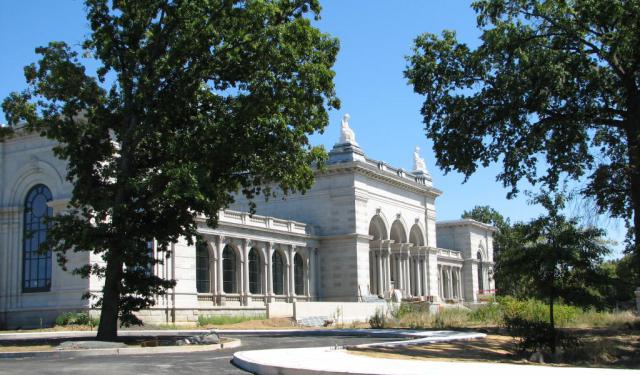University of Pennsylvania Walking Tour (Self Guided), Philadelphia
As America's first university, The University of Pennsylvania (aka Penn or Upenn, for short) has a history stretching back to the mid-18th century, closely bound with the city's colonial past and the birth of the United States. Initially, this Ivy League institution emerged as the College of Philadelphia, one of the nine colonial colleges chartered before the US Declaration of Independence. It was founded by Benjamin Franklin himself.
The university's 299-acre campus in West Philadelphia houses 12 schools, featuring extensive green spaces, recreational areas, heritage architecture, and notable landmarks such as Houston Hall and Franklin Field, making it a bustling academic hub in the region.
The heart of the campus is the Perelman Quadrangle, a picturesque green space surrounded by historic buildings. College Hall, an iconic structure, forms part of the Quadrangle and is the oldest building on the university's site, constructed in 1873.
The Fisher Fine Arts Library, often called the Furness Library, is a stunning architectural gem designed by renowned architect Frank Furness. It served as the primary library of the university from 1891 to 1962. Nearby, Fisher-Bennett Hall was the university's first facility built for women, in 1925.
One notable feature of the campus is "The Button," a piece of modern art installed in front of the Van Pelt Library (the university's primary library).
Further on, we'll visit the Quadrangle Dormitories (colloquially known as “The Quad”) designed by the Cope and Stewardson firm, providing comfortable living spaces for students. Next to it, Provost's Tower, a tribute to Penn's provosts since 1912, offers a panoramic view of the campus and the city.
Irvine Auditorium hosts various events, from lectures to performances, while the Penn Museum, also known as the University Museum of Archaeology & Anthropology, showcases fascinating artifacts from around the world.
Sports enthusiasts can cheer for the Penn Quakers at Franklin Field or enjoy basketball games at The Palestra, a historic sports arena with a storied past.
The University of Pennsylvania offers a remarkable academic environment with a blend of historic charm and modern facilities. For a closer acquaintance with its attractions, take this self-guided walk and discover the vibrant academic and cultural life this prestigious institution has to offer.
The university's 299-acre campus in West Philadelphia houses 12 schools, featuring extensive green spaces, recreational areas, heritage architecture, and notable landmarks such as Houston Hall and Franklin Field, making it a bustling academic hub in the region.
The heart of the campus is the Perelman Quadrangle, a picturesque green space surrounded by historic buildings. College Hall, an iconic structure, forms part of the Quadrangle and is the oldest building on the university's site, constructed in 1873.
The Fisher Fine Arts Library, often called the Furness Library, is a stunning architectural gem designed by renowned architect Frank Furness. It served as the primary library of the university from 1891 to 1962. Nearby, Fisher-Bennett Hall was the university's first facility built for women, in 1925.
One notable feature of the campus is "The Button," a piece of modern art installed in front of the Van Pelt Library (the university's primary library).
Further on, we'll visit the Quadrangle Dormitories (colloquially known as “The Quad”) designed by the Cope and Stewardson firm, providing comfortable living spaces for students. Next to it, Provost's Tower, a tribute to Penn's provosts since 1912, offers a panoramic view of the campus and the city.
Irvine Auditorium hosts various events, from lectures to performances, while the Penn Museum, also known as the University Museum of Archaeology & Anthropology, showcases fascinating artifacts from around the world.
Sports enthusiasts can cheer for the Penn Quakers at Franklin Field or enjoy basketball games at The Palestra, a historic sports arena with a storied past.
The University of Pennsylvania offers a remarkable academic environment with a blend of historic charm and modern facilities. For a closer acquaintance with its attractions, take this self-guided walk and discover the vibrant academic and cultural life this prestigious institution has to offer.
How it works: Download the app "GPSmyCity: Walks in 1K+ Cities" from Apple App Store or Google Play Store to your mobile phone or tablet. The app turns your mobile device into a personal tour guide and its built-in GPS navigation functions guide you from one tour stop to next. The app works offline, so no data plan is needed when traveling abroad.
University of Pennsylvania Walking Tour Map
Guide Name: University of Pennsylvania Walking Tour
Guide Location: USA » Philadelphia (See other walking tours in Philadelphia)
Guide Type: Self-guided Walking Tour (Sightseeing)
# of Attractions: 12
Tour Duration: 2 Hour(s)
Travel Distance: 2.2 Km or 1.4 Miles
Author: leticia
Sight(s) Featured in This Guide:
Guide Location: USA » Philadelphia (See other walking tours in Philadelphia)
Guide Type: Self-guided Walking Tour (Sightseeing)
# of Attractions: 12
Tour Duration: 2 Hour(s)
Travel Distance: 2.2 Km or 1.4 Miles
Author: leticia
Sight(s) Featured in This Guide:
- Perelman Quadrangle
- College Hall
- Fisher Fine Arts Library
- Fisher-Bennett Hall
- The Button (sculpture)
- Van Pelt Library
- Quadrangle Dormitories
- Provosts Tower
- Irvine Auditorium
- Penn Museum. University Museum of Archaeology & Anthropology
- Franklin Field
- The Palestra
1) Perelman Quadrangle
The Perelman Quadrangle comprises a set of event venues situated on the campus of the University of Pennsylvania, located in the University City area of Philadelphia. The Perelman Quadrangle primarily revolves around a central plaza located between Houston and College halls, with additional event spaces spread out across the wider Penn campus.
Houston Hall, constructed in 1895, serves as Penn's student union building and is considered by some as the first of its kind in the United States. In 1978, it was listed as a contributing property in the National Register of Historic Places within the University of Pennsylvania Campus Historic District. Today, Houston Hall houses a cafeteria, various dining options, study rooms, auditoriums, and numerous meeting rooms and offices.
College Hall, Penn's inaugural building on its West Philadelphia campus, dating back to 1871, stands just across the plaza and accommodates most of the university's classrooms and administrative spaces.
Additionally, facing the plaza are Claudia Cohen Hall, initially constructed in 1874, and Irvine Auditorium, completed in 1932. Originally known as Logan Hall, Cohen Hall currently houses administrative offices, meeting rooms, and several academic departments. It was originally built for the university's medical school, later serving as the home of the dental school and subsequently the Wharton School. The Irvine building boasts a grand auditorium featuring a significant pipe organ gifted by Cyrus Curtis, and it also includes various smaller performance and rehearsal spaces. Williams Hall, built in 1972, overlooks the plaza and contains offices and classrooms for humanities and language departments.
Houston Hall, constructed in 1895, serves as Penn's student union building and is considered by some as the first of its kind in the United States. In 1978, it was listed as a contributing property in the National Register of Historic Places within the University of Pennsylvania Campus Historic District. Today, Houston Hall houses a cafeteria, various dining options, study rooms, auditoriums, and numerous meeting rooms and offices.
College Hall, Penn's inaugural building on its West Philadelphia campus, dating back to 1871, stands just across the plaza and accommodates most of the university's classrooms and administrative spaces.
Additionally, facing the plaza are Claudia Cohen Hall, initially constructed in 1874, and Irvine Auditorium, completed in 1932. Originally known as Logan Hall, Cohen Hall currently houses administrative offices, meeting rooms, and several academic departments. It was originally built for the university's medical school, later serving as the home of the dental school and subsequently the Wharton School. The Irvine building boasts a grand auditorium featuring a significant pipe organ gifted by Cyrus Curtis, and it also includes various smaller performance and rehearsal spaces. Williams Hall, built in 1972, overlooks the plaza and contains offices and classrooms for humanities and language departments.
2) College Hall
College Hall stands as the oldest structure on the campus of the University of Pennsylvania in West Philadelphia. Before its construction, the university's location was at Ninth Street in Center City, Philadelphia. This architectural marvel was designed by Thomas Webb Richards and completed in 1873. The distinct green hue of the building is attributed to its use of green serpentine stone in its construction.
On February 14, 1978, College Hall was designated as a historic site and added to the National Register of Historic Places. It also contributes to the overall historical significance of the University of Pennsylvania Campus Historic District.
Today, College Hall serves various purposes, including housing the undergraduate admissions office, the offices of the university president, the Department of History, and classrooms. The top floor of the building was specifically designed to accommodate the Zelosophic and Philomathean Societies and now serves as the home for the Philomathean Society, a literary organization established in 1813.
While there have been speculations that College Hall, along with the now-demolished Blanchard Hall, served as the inspiration for the Victorian Gothic mansion in The Addams Family cartoons, the cartoonist Charles Addams consistently refuted these claims.
On February 14, 1978, College Hall was designated as a historic site and added to the National Register of Historic Places. It also contributes to the overall historical significance of the University of Pennsylvania Campus Historic District.
Today, College Hall serves various purposes, including housing the undergraduate admissions office, the offices of the university president, the Department of History, and classrooms. The top floor of the building was specifically designed to accommodate the Zelosophic and Philomathean Societies and now serves as the home for the Philomathean Society, a literary organization established in 1813.
While there have been speculations that College Hall, along with the now-demolished Blanchard Hall, served as the inspiration for the Victorian Gothic mansion in The Addams Family cartoons, the cartoonist Charles Addams consistently refuted these claims.
3) Fisher Fine Arts Library
The Fisher Fine Arts Library served as the main library for the University of Pennsylvania from 1891 to 1962. It was an impressive architectural creation designed by the renowned Philadelphia architect Frank Furness (1839–1912). This imposing structure, constructed from red sandstone, brick, and terra-cotta in the Venetian Gothic style, combined elements of a fortress and a cathedral. Construction began with the laying of the cornerstone in October 1888, and it was finished in late 1890, with the official dedication taking place in February 1891.
The library's uniqueness stemmed from its innovative layout, featuring a central tower staircase as the main access to its five stories. The Main Reading Room, a spacious four-story area enclosed by brick and terra-cotta, was separated from the two-story Rotunda Reading Room by an arcade. Above the Rotunda Reading Room was a two-story lecture hall, currently used as an architecture studio. The Main Reading Room stood out for its large skylight and south-facing wall of windows, providing natural light to the adjacent inner rooms through leaded glass windows.
Throughout the building, one could find windows adorned with Shakespearean quotations, carefully selected by Horace Howard Furness, Frank's older brother, who was a lecturer at the University and a prominent American Shakespearean scholar in the 19th century. Frank Furness collaborated with Melvil Dewey, the creator of the Dewey Decimal System, and others to ensure that this library was at the forefront of modern American library design during its time.
Upon the completion of the Van Pelt Library in 1962, the library was renamed the Furness Building in honor of its architect. It was repurposed to house the university's art and architecture collections. In 1985, it received recognition as a National Historic Landmark.
In 1991, after a six-year, $16.5-million restoration project, the building was renamed the Anne and Jerome Fisher Fine Arts Library. It is situated on the eastern side of College Green. Additionally, a two-story extension to the building's east side, known as the Henry Charles Lea Library, was designed by Furness, Evans & Company and was completed in 1905.
The library's uniqueness stemmed from its innovative layout, featuring a central tower staircase as the main access to its five stories. The Main Reading Room, a spacious four-story area enclosed by brick and terra-cotta, was separated from the two-story Rotunda Reading Room by an arcade. Above the Rotunda Reading Room was a two-story lecture hall, currently used as an architecture studio. The Main Reading Room stood out for its large skylight and south-facing wall of windows, providing natural light to the adjacent inner rooms through leaded glass windows.
Throughout the building, one could find windows adorned with Shakespearean quotations, carefully selected by Horace Howard Furness, Frank's older brother, who was a lecturer at the University and a prominent American Shakespearean scholar in the 19th century. Frank Furness collaborated with Melvil Dewey, the creator of the Dewey Decimal System, and others to ensure that this library was at the forefront of modern American library design during its time.
Upon the completion of the Van Pelt Library in 1962, the library was renamed the Furness Building in honor of its architect. It was repurposed to house the university's art and architecture collections. In 1985, it received recognition as a National Historic Landmark.
In 1991, after a six-year, $16.5-million restoration project, the building was renamed the Anne and Jerome Fisher Fine Arts Library. It is situated on the eastern side of College Green. Additionally, a two-story extension to the building's east side, known as the Henry Charles Lea Library, was designed by Furness, Evans & Company and was completed in 1905.
4) Fisher-Bennett Hall
Situated at a somewhat unusual site – the juncture of three streets (Walnut, 34th, and the diagonal of the former Woodland Avenue), Bennett Hall has just as unusual plan, determined by the location, with its main façade being on the beveled corner. Because of the slope of the site, the actual height of the building varies from four to six stories.
The symmetrical principal façade is dominated by a central tower over the main entrance, with articulated decorative buttresses crowned by corner spires. The tower is flanked by two-story windows below a battlement at the roof line.
Still, it is not so much the architecture that distinguishes this building, but the fact that it was the first facility at the University built specifically for women. Originally known as Bennett College, the edifice was erected in 1925, designed by architects Stewardson & Page. Inside, other than classrooms, it had a library, a gymnasium and a student union. An important landmark for the campus, the building was generously renovated and upgraded in 2005. Upon re-opening in 2006, it was renamed Fisher-Bennett Hall. Presently, the facility houses the English Department, English Language Programs, Music Department and Cinema Studies among other occupants.
The symmetrical principal façade is dominated by a central tower over the main entrance, with articulated decorative buttresses crowned by corner spires. The tower is flanked by two-story windows below a battlement at the roof line.
Still, it is not so much the architecture that distinguishes this building, but the fact that it was the first facility at the University built specifically for women. Originally known as Bennett College, the edifice was erected in 1925, designed by architects Stewardson & Page. Inside, other than classrooms, it had a library, a gymnasium and a student union. An important landmark for the campus, the building was generously renovated and upgraded in 2005. Upon re-opening in 2006, it was renamed Fisher-Bennett Hall. Presently, the facility houses the English Department, English Language Programs, Music Department and Cinema Studies among other occupants.
5) The Button (sculpture)
The Button, also known as the Split Button, is a contemporary art sculpture situated at the heart of the University of Pennsylvania campus. It was created by Claes Oldenburg, a Swedish artist renowned for crafting oversized sculptures inspired by ordinary objects.
When The Button was installed in front of the Van Pelt Library on June 18, 1981, it sparked significant controversy. Some students regarded the structure as intrusive and believed it did not enhance the appearance of College Green. Although the controversy surrounding the artwork has diminished over the years since 1981, it has nonetheless become a prominent landmark and focal point of the campus.
A popular legend, primarily circulated by University of Pennsylvania students, attributes the creation of The Button to the university's founder, Benjamin Franklin. According to the tale, a monument of Franklin seated nearby depicts a moment when the corpulent figure sat down, causing his vest button to pop off and roll across Locust Walk on the university grounds. Eventually, the button came to a halt and split into two pieces, giving rise to the sculpture we see today.
Oldenburg, however, offers an alternative interpretation. He once explained that "The Split represents the Schuylkill River, dividing the button into four sections, symbolizing William Penn's original Philadelphia squares."
The name of The Button has even lent itself to a satirical blog at Penn, known as Under the Button.
When The Button was installed in front of the Van Pelt Library on June 18, 1981, it sparked significant controversy. Some students regarded the structure as intrusive and believed it did not enhance the appearance of College Green. Although the controversy surrounding the artwork has diminished over the years since 1981, it has nonetheless become a prominent landmark and focal point of the campus.
A popular legend, primarily circulated by University of Pennsylvania students, attributes the creation of The Button to the university's founder, Benjamin Franklin. According to the tale, a monument of Franklin seated nearby depicts a moment when the corpulent figure sat down, causing his vest button to pop off and roll across Locust Walk on the university grounds. Eventually, the button came to a halt and split into two pieces, giving rise to the sculpture we see today.
Oldenburg, however, offers an alternative interpretation. He once explained that "The Split represents the Schuylkill River, dividing the button into four sections, symbolizing William Penn's original Philadelphia squares."
The name of The Button has even lent itself to a satirical blog at Penn, known as Under the Button.
6) Van Pelt Library
The Charles Patterson Van Pelt Library, commonly referred to as the Van Pelt-Dietrich Library Center or simply Van Pelt, stands as the centerpiece of the University of Pennsylvania's library system. Designed by the architectural firm Harbeson, Hough, Livingston & Larson, this significant building was constructed in 1962 and boasts an impressive gross area of 201,215 square feet (18,693 square meters).
Van Pelt is not just a hub for social sciences and humanities research but also accommodates several specialized libraries and collections. It is home to the Lippincott Library of The Wharton School, renowned for its business resources, and the Ormandy Music Library, catering to music-related studies. Moreover, the Kislak Center for Special Collections, Rare Books, and Manuscripts is housed here, offering a wealth of rare and unique materials.
The library's Area Studies collections are particularly notable, with extensive resources in African, Japanese, Latin American, Chinese, Middle East, South Asia, and Judaica & Ancient Near East Studies. Adding to its academic richness is the Henry Charles Lea Library, located on the 6th floor, known for its historical collections.
Architecturally, Van Pelt Library presents a blend of styles. Its vaguely Grecian appearance, marked by a significant colonnade, is juxtaposed with brick panels and small windows, reminiscent of an old French library, creating a distinctive aesthetic on the campus. Additionally, a modern art sculpture titled "The Button" is prominently placed at the library's southern entrance, further accentuating its modern and eclectic character.
The library also features the Weigle Information Commons, situated on the west side of the first floor. This space is designed to facilitate information access and collaborative learning, underscoring the library's role as a dynamic and integral part of the university's academic landscape.
Van Pelt is not just a hub for social sciences and humanities research but also accommodates several specialized libraries and collections. It is home to the Lippincott Library of The Wharton School, renowned for its business resources, and the Ormandy Music Library, catering to music-related studies. Moreover, the Kislak Center for Special Collections, Rare Books, and Manuscripts is housed here, offering a wealth of rare and unique materials.
The library's Area Studies collections are particularly notable, with extensive resources in African, Japanese, Latin American, Chinese, Middle East, South Asia, and Judaica & Ancient Near East Studies. Adding to its academic richness is the Henry Charles Lea Library, located on the 6th floor, known for its historical collections.
Architecturally, Van Pelt Library presents a blend of styles. Its vaguely Grecian appearance, marked by a significant colonnade, is juxtaposed with brick panels and small windows, reminiscent of an old French library, creating a distinctive aesthetic on the campus. Additionally, a modern art sculpture titled "The Button" is prominently placed at the library's southern entrance, further accentuating its modern and eclectic character.
The library also features the Weigle Information Commons, situated on the west side of the first floor. This space is designed to facilitate information access and collaborative learning, underscoring the library's role as a dynamic and integral part of the university's academic landscape.
7) Quadrangle Dormitories
The Quadrangle Dormitories, commonly referred to as "The Quad," consist of 39 interconnected residential buildings located within the University of Pennsylvania. These structures were designed by the architectural firm Cope and Stewardson in a vibrant Neo-Jacobean interpretation of the Collegiate Gothic architectural style.
The majority of the dormitories were constructed between 1894 and 1912. They span from 36th to 38th Streets and from Spruce Street to Hamilton Walk, which used to be Pine Street. To the west of the Memorial Tower on 37th Street, the buildings on the north side align with the diagonal path of Woodland Avenue, now known as Woodland Walk, forming an elongated triangle when juxtaposed with the structures on the south side.
Historically, from 1895 to 1971, Quadrangle Dormitories exclusively accommodated male students. In 1978, they were recognized as a contributing property within the University of Pennsylvania Campus Historic District.
Presently, "The Quad" has been organized into three distinct college houses: Fisher Hassenfeld College House on the west, Ware College House in the center, and Riepe College House on the east. These college houses primarily serve as "first-year communities" and currently house around 1,445 students.
Fisher Hassenfeld College House, located on the western part of the Quad, honors Jerome and Anne Fisher, along with Alan G. Hassenfeld, all alumni and trustees who funded its establishment. Ware College House, in the central Quad area, is named after Congressman John H. Ware III and includes the Memorial Tower and buildings east of 37th Street. Riepe College House, on the eastern Quad section, was created with a $10 million pledge from James and Gail Petty Riepe in 2004.
The majority of the dormitories were constructed between 1894 and 1912. They span from 36th to 38th Streets and from Spruce Street to Hamilton Walk, which used to be Pine Street. To the west of the Memorial Tower on 37th Street, the buildings on the north side align with the diagonal path of Woodland Avenue, now known as Woodland Walk, forming an elongated triangle when juxtaposed with the structures on the south side.
Historically, from 1895 to 1971, Quadrangle Dormitories exclusively accommodated male students. In 1978, they were recognized as a contributing property within the University of Pennsylvania Campus Historic District.
Presently, "The Quad" has been organized into three distinct college houses: Fisher Hassenfeld College House on the west, Ware College House in the center, and Riepe College House on the east. These college houses primarily serve as "first-year communities" and currently house around 1,445 students.
Fisher Hassenfeld College House, located on the western part of the Quad, honors Jerome and Anne Fisher, along with Alan G. Hassenfeld, all alumni and trustees who funded its establishment. Ware College House, in the central Quad area, is named after Congressman John H. Ware III and includes the Memorial Tower and buildings east of 37th Street. Riepe College House, on the eastern Quad section, was created with a $10 million pledge from James and Gail Petty Riepe in 2004.
8) Provosts Tower
Located in the heart of Philadelphia, Provost Tower stands as a historic and architecturally significant structure on 36th Street, just south of Spruce Street. Constructed in 1912, this seven-story building functions as the grand entrance to the Lower Quad and holds immense historical value for the University of Pennsylvania.
The tower was named in honor of William Smith, the university's first provost, who served from 1755 to 1779 and again from 1789 to 1791. Smith's contributions were pivotal in shaping the early development of the college, which evolved into the prestigious University of Pennsylvania.
Interestingly, the construction of Provosts Tower was funded as a generous gift from the family and friends of Provost Charles Custis Harrison, to commemorate his retirement in 1910. This gesture symbolizes the deep respect and admiration for Harrison’s contributions to the university.
Adding to the tower's grandeur is a seated statue of Provost Harrison, positioned outside the building, overlooking the property with a sense of pride. This statue is not only a tribute to Harrison but also serves as a reminder of the enduring legacy of the university's leadership.
The building itself is a marvel of architectural design, featuring intricately carved limestone decorations by the sculptor Edward Maene. These decorations include plaques dedicated to each of the first 12 provosts of the university, signifying the tower’s role as a tribute to all the provosts who have served at the institution. Additionally, twin "headboards" embellished with the Coat of Arms of Pennsylvania adorn the parapet, adding to the building's aesthetic and historical significance.
One of the key features of Provosts Tower is its fifth floor, which houses a two-story library and lounge. This space not only serves as a functional area for study and relaxation but also as a physical embodiment of the university's commitment to academic excellence and the pursuit of knowledge.
The tower was named in honor of William Smith, the university's first provost, who served from 1755 to 1779 and again from 1789 to 1791. Smith's contributions were pivotal in shaping the early development of the college, which evolved into the prestigious University of Pennsylvania.
Interestingly, the construction of Provosts Tower was funded as a generous gift from the family and friends of Provost Charles Custis Harrison, to commemorate his retirement in 1910. This gesture symbolizes the deep respect and admiration for Harrison’s contributions to the university.
Adding to the tower's grandeur is a seated statue of Provost Harrison, positioned outside the building, overlooking the property with a sense of pride. This statue is not only a tribute to Harrison but also serves as a reminder of the enduring legacy of the university's leadership.
The building itself is a marvel of architectural design, featuring intricately carved limestone decorations by the sculptor Edward Maene. These decorations include plaques dedicated to each of the first 12 provosts of the university, signifying the tower’s role as a tribute to all the provosts who have served at the institution. Additionally, twin "headboards" embellished with the Coat of Arms of Pennsylvania adorn the parapet, adding to the building's aesthetic and historical significance.
One of the key features of Provosts Tower is its fifth floor, which houses a two-story library and lounge. This space not only serves as a functional area for study and relaxation but also as a physical embodiment of the university's commitment to academic excellence and the pursuit of knowledge.
9) Irvine Auditorium
Irvine Auditorium, located on Spruce Street within the University of Pennsylvania's campus in Philadelphia, is a performance venue with a rich history. Designed by the renowned Philadelphia architect Horace Trumbauer, the auditorium was constructed between 1926 and 1932. One of its standout features is the Curtis Organ, boasting nearly 11,000 pipes, making it the world's 22nd-largest pipe organ in terms of ranks. Originally built for the Sesquicentennial Exposition in 1926, it was generously donated to the university in 1928. The auditorium officially opened its doors in May 1929.
There's an enduring but inaccurate campus legend surrounding Irvine Auditorium. According to this story, the building was the brainchild of a Penn architecture student whose design project received a failing grade. He subsequently abandoned his architectural aspirations and ventured into business, eventually amassing a fortune. Many years later, he made a substantial bequest to the university in his will, but with the condition that his original project be brought to life.
The seating capacity of Irvine Auditorium currently stands at 1,260, though it used to accommodate 1,976 people prior to a renovation. The auditorium's design is octagonal, featuring side balconies that once faced each other at right angles to the stage. In a significant restoration and renovation effort spanning from 1997 to 2000, Venturi, Scott Brown & Associates, Inc. removed these side balconies. This not only enhanced the acoustic quality of the venue but also created more intimate performance spaces within the building.
There's an enduring but inaccurate campus legend surrounding Irvine Auditorium. According to this story, the building was the brainchild of a Penn architecture student whose design project received a failing grade. He subsequently abandoned his architectural aspirations and ventured into business, eventually amassing a fortune. Many years later, he made a substantial bequest to the university in his will, but with the condition that his original project be brought to life.
The seating capacity of Irvine Auditorium currently stands at 1,260, though it used to accommodate 1,976 people prior to a renovation. The auditorium's design is octagonal, featuring side balconies that once faced each other at right angles to the stage. In a significant restoration and renovation effort spanning from 1997 to 2000, Venturi, Scott Brown & Associates, Inc. removed these side balconies. This not only enhanced the acoustic quality of the venue but also created more intimate performance spaces within the building.
10) Penn Museum. University Museum of Archaeology & Anthropology
The Penn Museum, formerly known as the University of Pennsylvania Museum of Archaeology and Anthropology, is located on the University of Pennsylvania's campus in the University City neighborhood of Philadelphia. You can find it at the intersection of 33rd and South Streets. Established in 1887, the Penn Museum has actively participated in 400 research projects worldwide. Its inaugural project involved excavating Nippur, a historical site in present-day Iraq.
One of the museum's standout attractions is the largest authentic sphinx in North America, measuring approximately seven feet in height, four feet in width, 13 feet in length, and weighing a hefty 12.9 tons, crafted from solid red granite. This impressive artifact was unearthed in 1912 by the British archaeologist, Sir William Matthew Flinders Petrie, during his excavation of the ancient Egyptian city of Memphis. In its original context, the sphinx guarded a temple to protect against evil forces. Since Petrie's expedition received partial funding from the University of Pennsylvania, he offered the sphinx to the university, which arranged for its transfer to the museum in 1913. In 2019, the sphinx was relocated to a more prominent location within the museum to attract more visitors.
The Penn Museum features three gallery floors showcasing artifacts from various regions, including Egypt, the Middle East, Mesoamerica, Asia, the Mediterranean, Africa, and indigenous artifacts from the Americas. One of its most renowned pieces is a sculpture depicting a goat rearing up into the branches of a rosette-leafed plant, originating from the royal tombs of Ur.
Moreover, the Penn Museum's ongoing excavations and extensive collections provide valuable resources for graduate students studying the Art and Archaeology of the Mediterranean World within the Graduate Group. The museum's Beaux-Arts building boasts distinctive features like a rotunda and gardens adorned with Egyptian papyrus plants.
One of the museum's standout attractions is the largest authentic sphinx in North America, measuring approximately seven feet in height, four feet in width, 13 feet in length, and weighing a hefty 12.9 tons, crafted from solid red granite. This impressive artifact was unearthed in 1912 by the British archaeologist, Sir William Matthew Flinders Petrie, during his excavation of the ancient Egyptian city of Memphis. In its original context, the sphinx guarded a temple to protect against evil forces. Since Petrie's expedition received partial funding from the University of Pennsylvania, he offered the sphinx to the university, which arranged for its transfer to the museum in 1913. In 2019, the sphinx was relocated to a more prominent location within the museum to attract more visitors.
The Penn Museum features three gallery floors showcasing artifacts from various regions, including Egypt, the Middle East, Mesoamerica, Asia, the Mediterranean, Africa, and indigenous artifacts from the Americas. One of its most renowned pieces is a sculpture depicting a goat rearing up into the branches of a rosette-leafed plant, originating from the royal tombs of Ur.
Moreover, the Penn Museum's ongoing excavations and extensive collections provide valuable resources for graduate students studying the Art and Archaeology of the Mediterranean World within the Graduate Group. The museum's Beaux-Arts building boasts distinctive features like a rotunda and gardens adorned with Egyptian papyrus plants.
11) Franklin Field
Franklin Field, an iconic American sports stadium, holds a prominent place in Philadelphia, situated at the eastern edge of the University of Pennsylvania's campus. This historic venue serves multiple purposes, primarily as the home stadium for the Penn Relays, a renowned track and field event. It is also the primary facility for the University of Pennsylvania's football, track and field, lacrosse teams, and in the past, it accommodated soccer, field hockey, and baseball.
Beyond its use for intercollegiate athletics, Franklin Field is a hub of student activity, facilitating recreational sports, intramural, and club sports, including touch football and cricket. It also has the distinction of being the chosen location for the University's graduation ceremonies, weather permitting.
Franklin Field's historical significance is further highlighted by its recognition by the NCAA as the oldest stadium still in operation for football in the United States. Its pioneering features include being the first U.S. stadium with an upper deck of seats and a scoreboard. In 1922, it achieved another first: the site of the initial radio broadcast of a football game on WIP, and also the venue for the first television broadcast of a football game by Philco.
From 1958 to 1970, Franklin Field expanded its legacy in professional sports by serving as the home field for the Philadelphia Eagles of the National Football League.
Moreover, the stadium is etched in political history as well. It was here in 1936 that President Franklin D. Roosevelt delivered a significant speech, accepting the Democratic Party's nomination for a second term as president. This event drew an impressive crowd of around 100,000 people, who braved intermittent rain to hear FDR's address at Franklin Field.
Beyond its use for intercollegiate athletics, Franklin Field is a hub of student activity, facilitating recreational sports, intramural, and club sports, including touch football and cricket. It also has the distinction of being the chosen location for the University's graduation ceremonies, weather permitting.
Franklin Field's historical significance is further highlighted by its recognition by the NCAA as the oldest stadium still in operation for football in the United States. Its pioneering features include being the first U.S. stadium with an upper deck of seats and a scoreboard. In 1922, it achieved another first: the site of the initial radio broadcast of a football game on WIP, and also the venue for the first television broadcast of a football game by Philco.
From 1958 to 1970, Franklin Field expanded its legacy in professional sports by serving as the home field for the Philadelphia Eagles of the National Football League.
Moreover, the stadium is etched in political history as well. It was here in 1936 that President Franklin D. Roosevelt delivered a significant speech, accepting the Democratic Party's nomination for a second term as president. This event drew an impressive crowd of around 100,000 people, who braved intermittent rain to hear FDR's address at Franklin Field.
12) The Palestra
The Palestra, often referred to as the "Cathedral of College Basketball," is a historic sports arena situated on South 33rd Street in Philadelphia, on the campus of the University of Pennsylvania. This iconic venue serves as the home court for the Penn Quakers men's and women's basketball teams, as well as the volleyball and wrestling teams. Additionally, it plays a central role in Philadelphia Big 5 basketball.
Opening its doors on January 1, 1927, the Palestra holds a special place in the history of college basketball. It has been described as "the most significant building in the history of college basketball" and is credited with profoundly influencing the development of the sport it was designed for.
Originally designed to accommodate around 10,000 spectators, the arena's seating capacity for basketball games has since been adjusted to 8,725. What sets the Palestra apart is its unique seating arrangement, with bleachers that extend right down to the playing surface, providing an intimate and unobstructed view of the games, with no barriers separating the fans from the action.
Notably, during its construction, the Palestra was one of the largest arenas globally and represented a pioneering use of steel and concrete in American arena construction. It was among the first venues in the United States to be built without interior pillars, ensuring an unobstructed view for all attendees.
Throughout its existence, the Palestra has hosted more games, welcomed more visiting teams, and hosted more NCAA tournaments than any other college basketball facility, solidifying its status as an integral part of the sport's history.
Opening its doors on January 1, 1927, the Palestra holds a special place in the history of college basketball. It has been described as "the most significant building in the history of college basketball" and is credited with profoundly influencing the development of the sport it was designed for.
Originally designed to accommodate around 10,000 spectators, the arena's seating capacity for basketball games has since been adjusted to 8,725. What sets the Palestra apart is its unique seating arrangement, with bleachers that extend right down to the playing surface, providing an intimate and unobstructed view of the games, with no barriers separating the fans from the action.
Notably, during its construction, the Palestra was one of the largest arenas globally and represented a pioneering use of steel and concrete in American arena construction. It was among the first venues in the United States to be built without interior pillars, ensuring an unobstructed view for all attendees.
Throughout its existence, the Palestra has hosted more games, welcomed more visiting teams, and hosted more NCAA tournaments than any other college basketball facility, solidifying its status as an integral part of the sport's history.
Walking Tours in Philadelphia, Pennsylvania
Create Your Own Walk in Philadelphia
Creating your own self-guided walk in Philadelphia is easy and fun. Choose the city attractions that you want to see and a walk route map will be created just for you. You can even set your hotel as the start point of the walk.
Philadelphia Old City Walking Tour
King Charles II of England, while seriously indebted to Admiral Sir William Penn, settled his debt in 1681 by granting lands in America to William Penn, the Admiral's Quaker son. A thorn in the King's side, young Penn sailed to America, where he envisioned a utopian society based on tolerance and founded Philadelphia, the "City of Brotherly Love."
The Old City Center, the... view more
Tour Duration: 2 Hour(s)
Travel Distance: 3.2 Km or 2 Miles
The Old City Center, the... view more
Tour Duration: 2 Hour(s)
Travel Distance: 3.2 Km or 2 Miles
Philadelphia Introduction Walking Tour
The sixth largest city in the United States and the largest in the Commonwealth of Pennsylvania, Philadelphia is a dynamic city heaped with old-world charm and contemporary infrastructure. Notable for its rich history, primarily as the birthplace of "life, liberty, and the pursuit of happiness."
Often called Philly, Philadelphia is also known as the City of Brotherly Love – a... view more
Tour Duration: 2 Hour(s)
Travel Distance: 2.3 Km or 1.4 Miles
Often called Philly, Philadelphia is also known as the City of Brotherly Love – a... view more
Tour Duration: 2 Hour(s)
Travel Distance: 2.3 Km or 1.4 Miles
Franklin Parkway Walking Tour
Benjamin Franklin Parkway is a scenic boulevard running through the cultural heart of Philadelphia. Named for America's Founding Father, Benjamin Franklin, this mile-long tree-lined parkway is lined with several notable sights and world-class museums.
At its heart lies Logan Circle, a charming green space centered around a picturesque fountain. This spot can provide a refreshing break on... view more
Tour Duration: 2 Hour(s)
Travel Distance: 2.6 Km or 1.6 Miles
At its heart lies Logan Circle, a charming green space centered around a picturesque fountain. This spot can provide a refreshing break on... view more
Tour Duration: 2 Hour(s)
Travel Distance: 2.6 Km or 1.6 Miles
Rocky Movie Sites Walking Tour
There's hardly any other character, fictional or real, as iconically Philadelphian as Rocky. Indeed, this American sports drama franchise, centered on the boxing career of Rocky Balboa, released in 1976, has become synonymous with and arguably done more for the city of Philadelphia than anyone else since Ben Franklin.
The cultural phenomenon was created by Sylvester Stallone, who wrote,... view more
Tour Duration: 3 Hour(s)
Travel Distance: 6.3 Km or 3.9 Miles
The cultural phenomenon was created by Sylvester Stallone, who wrote,... view more
Tour Duration: 3 Hour(s)
Travel Distance: 6.3 Km or 3.9 Miles
Benjamin Franklin's Philadelphia
Benjamin Franklin's journey to becoming one of the most influential figures in Revolutionary America began when he, as a teenager, ventured from a Puritan family in Boston to Philadelphia. This city would not only become his home but also a stage for his remarkable life as a writer, printer, philosopher, postmaster, scientist, inventor, statesman, and diplomat. His life epitomizes the... view more
Tour Duration: 2 Hour(s)
Travel Distance: 2.5 Km or 1.6 Miles
Tour Duration: 2 Hour(s)
Travel Distance: 2.5 Km or 1.6 Miles
Fairmount Park Historical Houses Walking Tour
Fairmount Park, Philadelphia's oldest park, established since 1867, is also the city's largest municipal park, sprawling over 2,000 acres adjacent to the banks of the Schuylkill River. The park grew out of the Lemon Hill estate of Henry Pratt, whose land was originally owned by Robert Morris, signer of the Declaration of Independence.
In 1972, the park was placed on the National... view more
Tour Duration: 2 Hour(s)
Travel Distance: 4.7 Km or 2.9 Miles
In 1972, the park was placed on the National... view more
Tour Duration: 2 Hour(s)
Travel Distance: 4.7 Km or 2.9 Miles
Useful Travel Guides for Planning Your Trip
Philadelphia Souvenirs: 13 Unique Gift Ideas from the City of Brotherly Love
Looking for a great gift while visiting Philadelphia? Famous for its history, arts and culture, championship sports teams, and award-winning food and drink, Philadelphia is a top-rated shopping destination. Here, you'll find an amazing selection of items to choose from - something uniquely...
The Most Popular Cities
/ view all
